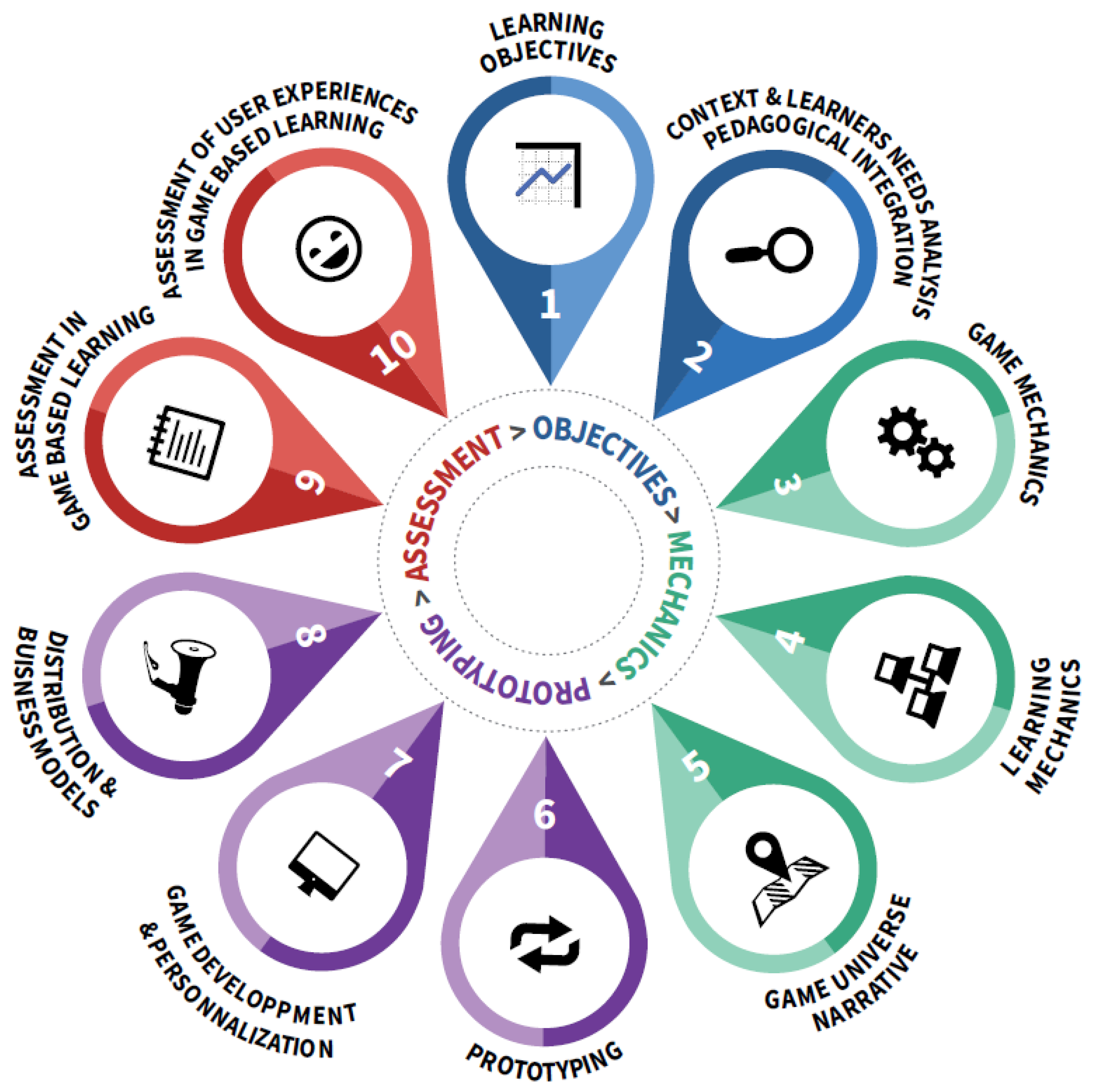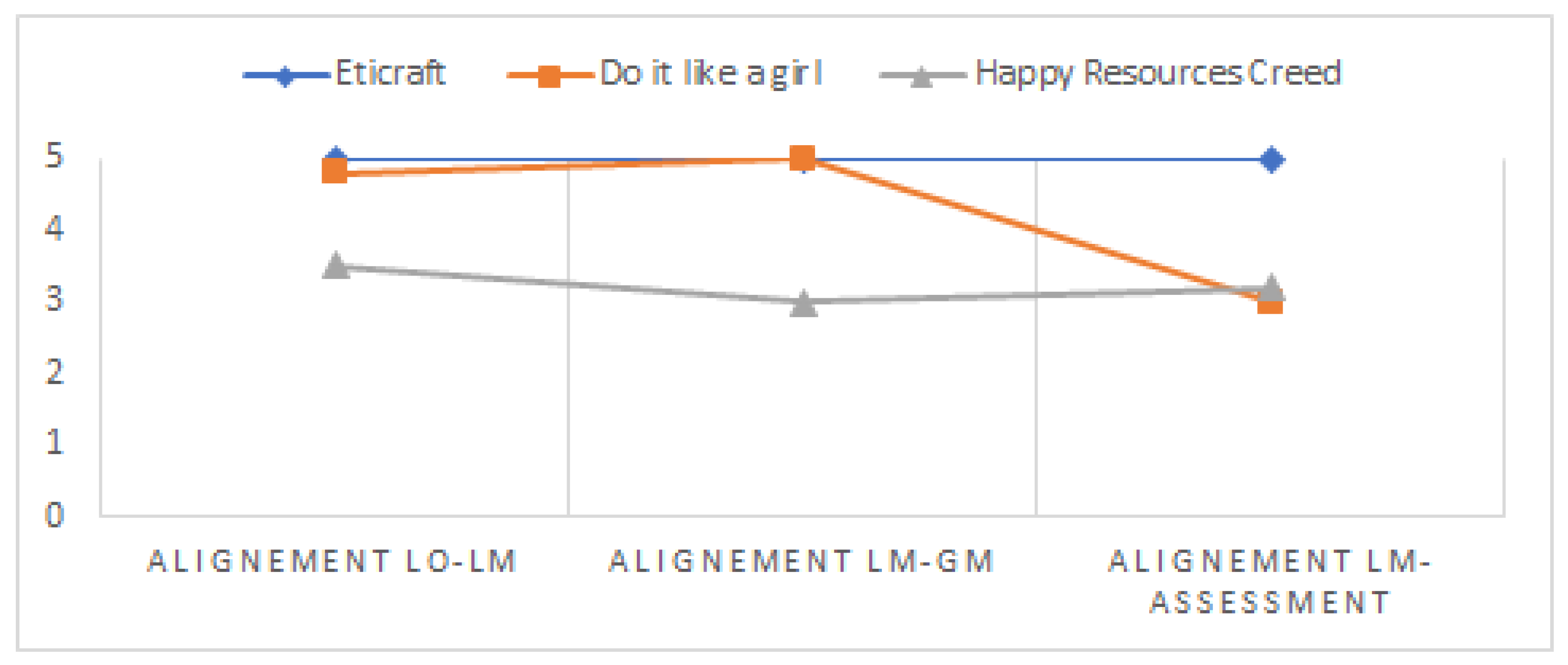Constructive Alignment in Game Design for Learning Activities in Higher Education
Abstract
1. Introduction
2. Game Design for Learning in Higher Education
3. Frameworks for Game Design in Educational Settings
4. Constructive Alignment under the Lens of Game Design
5. Method
5.1. Context of the Game Design Activity
- Learning goals: defining the learning goals of the proposed activity
- Analyzing context and learner needs and pedagogical integration: understanding the individual needs of one’s learners as well as the context around which the game is to be designed
- Game mechanics: proposing the game mechanics for the envisioned game
- Learning mechanics: proposing the learning mechanics for the envisioned game
- Game universe and game narrative: establishing the narrative elements of one’s game, considering the game and learning mechanics of the envisioned game
- Prototyping: working on a prototype version of the envisioned game
- Development: developing a playable version of the envisioned game
- Economic and distribution models: reflecting upon and setting the monetizing models, as well as finding distribution channels for one’s game
- Assessment and learning transfer: finding and proposing tools and methods for assessment of one’s game regarding transfer of knowledge and skills acquired while playing the game
- Assessment of play experience and usability: finding and proposing tools and methods for assessment of one’s game regarding play experience and usability
5.2. Constructive Alignment as an Assessment Tool for the Course’s Effectiveness
- the degree of coherence between the learning objectives (LO) and the game objectives (GO);
- between the learning mechanics (LM) and game mechanics (GM), and finally;
- between the learning mechanics (LM) and the assessment.
6. Results
7. Discussion and Future Work
8. Limitations of the Study
Author Contributions
Funding
Conflicts of Interest
References
- Gurukkal, R. Outcome-Based Education: An Open Framework. High. Educ. Future 2020, 7, 1–4. [Google Scholar] [CrossRef]
- Biggs, J. Aligning teaching for constructing learning. Available online: https://uncw.edu/cas/assessment/docs/alignment/biggsid477_aligning_teaching_for_constructing_learning.pdf (accessed on 25 February 2020).
- Tait, C. Chinese Students’ Perceptions of the Effects of Western University Examination Formats on their Learning. High. Educ. Q. 2010, 64, 261–275. [Google Scholar] [CrossRef]
- Sweller, J. Cognitive load theory, learning difficulty, and instructional design. Learn. Instr. 1994, 4, 295–312. [Google Scholar] [CrossRef]
- Benko, M.H.; Vogelsang, K.M.; Johnson, K.C.; Babij, A.R. Strategies to Prevent Cognitive Overload: A Team-Based Approach to Improving Student Success and Persistence in a Gateway Introductory Chemistry Course. Enhancing Retention in Introductory Chemistry Courses: Teaching Practices and Assessments; American Chemical Society: Washington, DC, USA, 2019; Volume 1330, pp. 187–200. [Google Scholar]
- Kalmpourtzis, G. Educational Game Design Fundamentals: A Journey to Creating Intrinsically Motivating Learning Experiences; AK Peters/CRC Press: New York, NY, USA, 2018. [Google Scholar]
- Sanchez, E.; Sanchez, E.; Kalmpourtzis, G.; Cazes, J.; Berthoix, M. Learning with Tactileo Map: From Gamification to Ludicization of Fieldwork Learning with Tactileo Map: From Gamification to Ludicization of Fieldwork; Wichmann: Berlin, Germany, 2015; pp. 261–271. [Google Scholar] [CrossRef]
- Taub, M.; Sawyer, R.; Smith, A.; Rowe, J.; Azevedo, R.; Lester, J. The agency effect: The impact of student agency on learning, emotions, and problem-solving behaviors in a game-based learning environment. Comput. Educ. 2020, 147, 103781. [Google Scholar] [CrossRef]
- Hainey, T.; Connolly, T.M.; Boyle, E.A.; Wilson, A.; Razak, A. A systematic literature review of games-based learning empirical evidence in primary education. Comput. Educ. 2009, 102, 202–223. [Google Scholar] [CrossRef]
- Vlachopoulos, D.; Makri, A. The effect of games and simulations on higher education: A systematic literature review. Int. J. Educ. Technol. High. Educ. 2017, 14, 22. [Google Scholar] [CrossRef]
- Akcaoglu, M.; Gutierrez, A.P.; Hodges, C.B.; Sonnleitner, P. Game Design as a Complex Problem Solving Process. In Handbook of Research on Serious Games for Educational Applications; Zheng, R., Gardner, M., Eds.; Hershey: Delhi, PA, USA, 2017; pp. 217–233. [Google Scholar] [CrossRef]
- Yiannoutsou, N.; Kynigos, C. Game Kits: Metadesign considerations on game modding for learning. In Proceedings of the 15th International Conference on Interaction Design and Children - IDC ’16, Linz, Austria, 13–15 July 2016; pp. 583–588. [Google Scholar] [CrossRef]
- Domingues, J.; Correia, F.; Uzdurum, I.; Sampaio, P. The Profile of Forthcoming Quality Leaders: An Exploratory Factor Analysis. In Proceedings of the 2019 IEEE International Conference on Industrial Engineering and Engineering Management (IEEM), Macau, China, 15 December 2019; pp. 1606–1610. [Google Scholar]
- Romero, M.; Usart, M.; Ott, M. Can serious games contribute to developing and sustaining 21st century skills? Games Cult. 2015, 10, 148–177. [Google Scholar] [CrossRef]
- Rambe, P.; Mlambo, S. Using digital storytelling to externalise personal knowledge of research processes: The case of a Knowledge Audio repository. Internet High. Educ. 2014, 22, 11–23. [Google Scholar] [CrossRef]
- Arnab, S.; Clarke, S. Towards a trans-disciplinary methodology for a game-based intervention development process. Br. J. Educ. Technol. 2017, 48, 279–312. [Google Scholar] [CrossRef]
- Bellotti, F.; Berta, R.; Gloria, A.D.E.; Ursi, A.D. A Serious Game Model for Cultural Heritage; ACM: New York, NY, USA, 2012; Volume 5. [Google Scholar] [CrossRef]
- Cózar-Gutiérrez, R.; Sáez-López, J.M. Game-based learning and gamification in initial teacher training in the social sciences: An experiment with MinecraftEdu. Int. J. Educ. Technol. High. Educ. 2016, 13, 2. [Google Scholar] [CrossRef]
- Braghirolli, L.F.; Ribeiro, J.L.D.; Weise, A.D.; Pizzolato, M. Benefits of educational games as an introductory activity in industrial engineering education. Comput. Hum. Behav. 2016, 58, 315–324. [Google Scholar] [CrossRef]
- Barr, M. Student attitudes to games-based skills development: Learning from video games in higher education. Comput. Hum. Behav. 2018, 80, 283–294. [Google Scholar] [CrossRef]
- Lameras, P.; Arnab, S.; Dunwell, I.; Stewart, C.; Clarke, S.; Petridis, P. Essential features of serious games design in higher education: Linking learning attributes to game mechanics. Br. J. Educ. Technol. 2017, 48, 972–994. [Google Scholar] [CrossRef]
- Kafai, Y.B.; Burke, Q. Constructionist gaming: Understanding the benefits of making games for learning. Educ. Psychol. 2015, 50, 313–334. [Google Scholar] [CrossRef]
- Cheng, X.; Li, Y.; Sun, J.; Huang, J. Application of a novel collaboration engineering method for learning design: A case study. Br. J. Educ. Technol. 2015, 47, 803–818. [Google Scholar] [CrossRef]
- Huang, W.H. Evaluating learners’ motivational and cognitive processing in an online game-based learning environment. Comput. Hum. Behav. 2011, 27, 694–704. [Google Scholar] [CrossRef]
- Amory, A. Game object model version II: A theoretical framework for educational game development. Educ. Technol. Res. Dev. 2007, 55, 51–77. [Google Scholar] [CrossRef]
- Arnab, S. Mapping learning and game mechanics for serious games analysis: Mapping learning and game mechanics. Br. J. Educ. Technol. 2015, 46, 391–411. [Google Scholar] [CrossRef]
- Carvalho, M.B. Computers & Education An activity theory-based model for serious games analysis and conceptual design. Comput. Educ. 2015, 87, 166–181. [Google Scholar] [CrossRef]
- Romero, M.; Lille, B.; Patino, A. Usages Créatifs du Numérique pour L’apprentissage au XXIe Siècle; Presses de l’Université du Québec: Québec, QC, Canda, 2017; Volume 1. [Google Scholar]
- de Freitas, S. Hot Issues in Game Enhanced Learning: The GEL Viewpoint. Procedia Comput. Sci. 2012, 15, 25–31. [Google Scholar] [CrossRef]
- Sanchez, E.; Young, S.; Jouneau-Sion, C. Classcraft: From gamification to ludicization of classroom management. Educ. Inf. Technol. 2017, 22, 497–513. [Google Scholar] [CrossRef]
- Djaouti, D.; Alvarez, J. The Creation of Newsgames as a Teaching Method - Empirical Observations. In Educational Game Design Fundamentals: A Journey to Creating Intrinsically Motivating Learning Experiences; Kalmpourtzis, G., Ed.; CRC Press: Boca Raton, FL, USA, 2018; pp. 72–77. [Google Scholar]
- Kalmpourtzis, G. Developing kindergarten students’ game design skills by teaching game design through organized game design interventions. Multimed. Tools Appl. 2019, 78, 1–26. [Google Scholar] [CrossRef]
- Sanchez, E.; Monod-Ansaldi, R.; Vincent, C.; Safadi-Katouzian, S. A praxeological perspective for the design and implementation of a digital role-play game. Educ. Inf. Technol. 2017, 22, 2805–2824. [Google Scholar] [CrossRef]
- Gaeta, E.; Beltrán-Jaunsaras, M.E.; Cea, G.; Spieler, B.; Burton, A.; García-Betances, R.B.; Cabrera-Umpiérrez, M.F.; Brown, D.; Boulton, H.; Arredondo Waldmeyer, M.T. Evaluation of the Create@School Game-Based Learning-Teaching Approach. Sensors 2019, 19, 3251. [Google Scholar] [CrossRef] [PubMed]
- Romero, M.; Arnab, S.; de Smet, C. Co-creativity assessment in the process of game creation. In Proceedings of the ECGBL, Sophia Antipolis, France, 4–5 October 2018. [Google Scholar]
- Sanchez, E. Toward a Play Management System for Play-Based Learning. In Adaptive and Adaptable Learning. EC-℡ 2016; Verbert, K., Sharples, M., Klobucar, T., Eds.; Springer: Berlin/Heidelberg, Germany, 2016; pp. 484–489. [Google Scholar]
- Bellotti, F.; Berta, R.; Gloria, D.A.; Ott, M. Supporting Collaborative Serious Game Studies Online. Revised Selected Papers of the 4th International Conference on Games and Learning Alliance - Volume 9599; Springer: Berlin/Heidelberg, Germany, 2015; pp. 228–237. [Google Scholar] [CrossRef]
- Jager, J.; Korkut, S.; Hil, D.; Dornberger, R. The Application of a Content Independent Game Framework in Higher Education. In Proceedings of the 9th European Conference on Game Based Learning, Steinkjer, Norway, 8–9 October 2015; p. 250. [Google Scholar]
- Plumettaz-sieber, M.; Hulaas, J.; Sanchez, E.; Jaccard, D. Co-Design of a Serious Game for Computing Education; Springer: Basel, Switzerland, 2019. [Google Scholar]
- de Freitas, S.; Jarvis, S. A Framework for Developing Serious Games to meet Learner Needs; National Training and Simulation Association: Arlington, TX, USA, 2006; p. 11. [Google Scholar]
- Bloom, B.S. Taxonomy of Educational Objectives. Educ. Psychol. Meas. 1956, 16, 401–405. [Google Scholar] [CrossRef]
- Bartholomew, L.K.; Parcel, G.S.; Kok, G. Intervention Mapping: A Process for Developing Theory and Evidence-Based Health Education Programs. Health Educ. Behav. 1998, 25, 545–563. [Google Scholar] [CrossRef]
- Yip, J.; Clegg, T.; Bonsignore, E.; Gelderblom, H.; Rhodes, E.; Druin, A. Brownies or bags-of-stuff? Domain Expertise in Cooperative Inquiry with Children. 12th Int. Conf. Interact. Des. Child. IDC 13 2013, 1, 201–210. [Google Scholar] [CrossRef]
- Dankbaar, M. Serious games and blended learning; effects on performance and motivation in medical education. Perspect. Med. Educ. 2017, 6, 58–60. [Google Scholar] [CrossRef]
- Romero, M.; Dumont, L.; Barma, S. Digital Games and Learning; JFD: Montréal, QC, Canada, 2019. [Google Scholar]
- Suttie, N. Introducing the ‘serious games mechanics’ a theoretical framework to analyse relationships between ‘game’ and ‘pedagogical aspects’ of serious games. Procedia Comput. Sci. 2012, 15, 314–315. [Google Scholar] [CrossRef]
- Romero, M. Jeux Numériques et Apprentissages; JFD: Québec, QC, Canada, 2016. [Google Scholar]
- Sweller, J. Cognitive load theory. Psychol. Learn. Motiv. 2011, 55, 37–76. [Google Scholar]



© 2020 by the authors. Licensee MDPI, Basel, Switzerland. This article is an open access article distributed under the terms and conditions of the Creative Commons Attribution (CC BY) license (http://creativecommons.org/licenses/by/4.0/).
Share and Cite
Romero, M.; Kalmpourtzis, G. Constructive Alignment in Game Design for Learning Activities in Higher Education. Information 2020, 11, 126. https://doi.org/10.3390/info11030126
Romero M, Kalmpourtzis G. Constructive Alignment in Game Design for Learning Activities in Higher Education. Information. 2020; 11(3):126. https://doi.org/10.3390/info11030126
Chicago/Turabian StyleRomero, Margarida, and George Kalmpourtzis. 2020. "Constructive Alignment in Game Design for Learning Activities in Higher Education" Information 11, no. 3: 126. https://doi.org/10.3390/info11030126
APA StyleRomero, M., & Kalmpourtzis, G. (2020). Constructive Alignment in Game Design for Learning Activities in Higher Education. Information, 11(3), 126. https://doi.org/10.3390/info11030126





